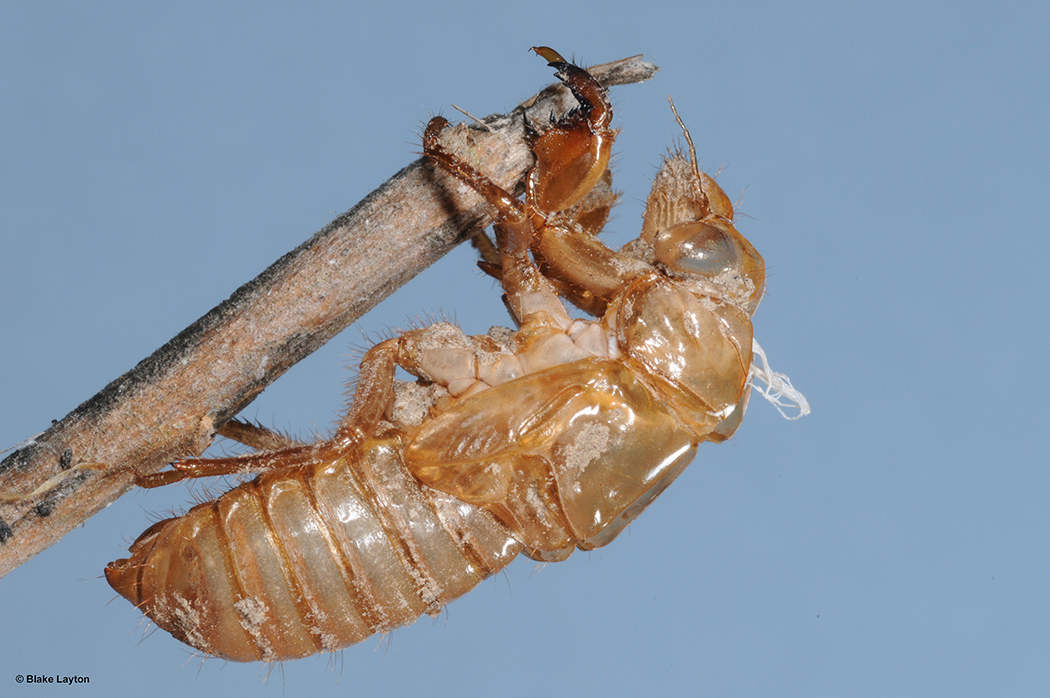Cicada Exuviae, Vol. 5, No. 21
Related News
June 20, 2013
April 11, 2013
April 2, 2013
March 14, 2013

When you start seeing cicada exuviae, a.k.a. shed cicada skins, hanging on the sides of trees, you know it is time to listen for adult cicadas singing in the trees. Exuviae is the technical term for the shed exoskeletons of insects or other arthropods. Most insects do not leave their exuviae hanging around where they are so easily seen, but cicadas are large insects and they have piercing-sucking mouthparts, which prevents them from eating their exuviae as do most insects with chewing mouthparts.
Finding a shed cicada skin provides a brief lesson in insect morphology and biology. Unlike vertebrates, insect have an external skeleton that is primarily composed of a flexible plastic-like material known a chitin. Because there are no internal bones, the muscles are attached to various points of the exoskeleton, allowing the muscles to have something to anchor onto and pull against when they contract in order to produce movement. Like our skin, the exoskeleton also serves as a barrier, protecting their bodies from the outside world. If you have ever peeled shrimp or crawfish, you are familiar with arthropod exoskeletons.
The exoskeleton of insects is somewhat like a suit of armor worn by a medieval knight. Imagine a little 6-year old squire fitted out in his own suit of armor, just like daddy’s. He may have fun at first, swaggering about in his armor and pretending to be a knight, but eventually the armor will grow too tight and must be discarded. This also happens with immature insects and other arthropods. Wise parents buying clothes for school-age kids know to allow room for growth. When an insect hatches from the egg, its exoskeleton has also room for growth, but eventually the exoskeleton becomes too tight and the insect must molt or “shed its skin,” a bit like snakes or other reptiles. This new exoskeleton has room for further growth, but again eventually becomes too tight, necessitating another molt.
This process continues until the insect becomes an adult, and then there are no more molts. Unlike reptiles, insects do not continue to grow after they become adults. For insects with complete life cycles, like beetles or moths, there is a final resting and reorganization stage, known as the pupal stage, before the insect emerges as an adult. But for insects with gradual life cycles, like aphids or cicadas, the transition from immature to adulthood occurs more rapidly. A wingless cicada nymph crawls out of the soil during the early part of the night, gets a good grip on some tree bark, splits its exoskeleton along the back, and emerges as a winged adult before dawn, leaving the shed exoskeleton behind for you to find.
Time for a corny bug joke.
What did one cicada exuvia say to the other?
“This molting process is so traumatic!”
“It sure is! We are nothing but shells of our former selves.”
See Bug’s Eye View No. 14 of 2015 for more information about annual cicadas.
http://extension.msstate.edu/
Blake Layton, Extension Entomology Specialist, Mississippi State University Extension Service. The information given here is for educational purposes only. Always read and follow current label directions. Specific commercial products are mentioned as examples only and reference to specific products or trade names is made with the understanding that no discrimination is intended to other products that may also be suitable and appropriately labeled.
Mississippi State University is an equal opportunity institution.